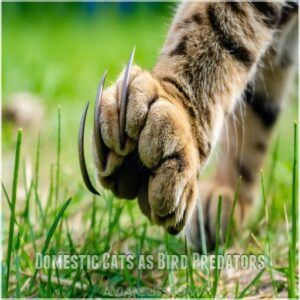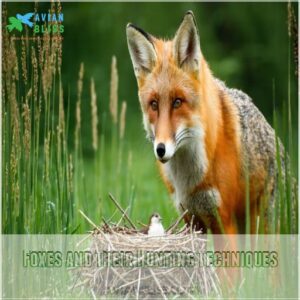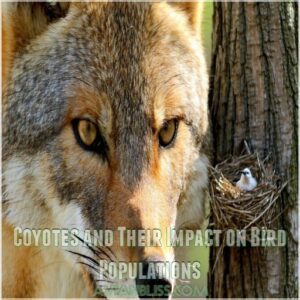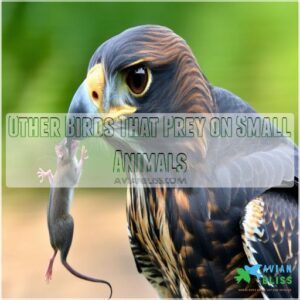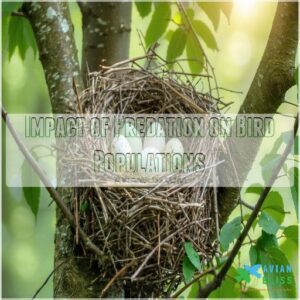This site is supported by our readers. We may earn a commission, at no cost to you, if you purchase through links.

These skilled hunters boast sharp talons and exceptional eyesight, making them aerial acrobats.
Foxes and domestic cats aren’t far behind, as they cunningly target ground-nesting birds.
Squirrels, often seen as cute nuisances, raid nests like tiny pirates.
Even snakes join the fray by preying on eggs and nestlings.
Humans, surprisingly, pose one of the largest threats due to habitat destruction.
Understanding these predator-prey dynamics gives you more than just trivia—it’s knowledge that empowers conservation efforts and offers a glimpse into nature’s balancing act.
Table Of Contents
- Key Takeaways
- Animals That Prey on Birds
- Domestic Cats as Bird Predators
- Foxes and Their Hunting Techniques
- Squirrels as Nest Raiders
- Raccoons and Their Role in Bird Predation
- Snakes as Predators of Bird Eggs and Nestlings
- Coyotes and Their Impact on Bird Populations
- Weasels as Small but Powerful Predators
- Humans as a Major Threat to Bird Populations
- Types of Birds of Prey
- Characteristics of Birds of Prey
- Other Birds That Prey on Small Animals
- Impact of Predation on Bird Populations
- Frequently Asked Questions (FAQs)
- Do birds have predators?
- Why are birds of prey apex predators?
- What are birds of prey?
- What predators eat small birds?
- How do predator birds find prey?
- Why do birds eat predators?
- What is a bird’s main predator?
- What is an interesting fact about birds of prey?
- How do birds survive predators?
- What bird is the top predator?
- How do birds of prey catch their food?
- What are the main defenses of birds?
- Do all birds of prey hunt?
- Which birds are most vulnerable to predators?
- How do bird populations recover from attacks?
- Conclusion
Key Takeaways
- You’ll find that predators like domestic cats, foxes, and squirrels pose significant threats to bird populations, often targeting nests, eggs, and young birds with stealth and precision.
- Hawks and eagles are standout birds of prey, leveraging their exceptional vision and powerful talons to excel as top predators in the ecosystem.
- Human activities such as habitat loss and overhunting amplify the challenges birds face, making conservation efforts crucial to their survival.
- By participating in bird conservation, you can directly impact their populations, promoting habitat restoration and responsible behaviors to protect avian wildlife.
Animals That Prey on Birds
If you’re curious about what preys on birds, you’ll find a surprising variety of animals, from domestic cats to cunning foxes.
These predators have different methods, like squirrels raiding nests and snakes targeting eggs, all affecting bird populations in unique ways.
Domestic Cats as Bird Predators
Domestic cats pose a significant threat to birds, playing the role of stealthy hunters in our backyards. They’re equipped with patience and sharp claws, making bird safety a tricky feat.
Consider these points:
- Cats kill billions of birds yearly.
- Birds struggle with escape routes.
- Bird conservation needs awareness.
- Responsible cat ownership is essential.
- Solutions involve keeping cats indoors.
Foxes and Their Hunting Techniques
Foxes are skilled hunters with a knack for finding bird nests.
Their sharp senses come in handy, sniffing out potential snacks like they’re conducting a supermarket sweep.
Foxes use strategic hunting techniques, slowly approaching prey with silent, purposeful steps.
Whether raiding nests or catching unsuspecting birds, fox behavior showcases their adaptability in various environments, making them formidable predators.
Squirrels as Nest Raiders
Moving from sly foxes to squirrel antics, these agile tree-dwellers can wreak havoc in bird nests. Here’s how their behavior impacts bird populations:
- Egg Thieves: Look out for those little paws raiding nests.
- Nest Raiders: Sneaky enough to snag eggs quietly, often targeting nests near Squirrel Bird Feeders, making them a double threat.
- Predator Diet: Eggs and nestlings fuel their appetites.
- Homeowner Solutions: Secure nesting boxes to keep them out.
Raccoons and Their Role in Bird Predation
Raccoons, those masked bandits of the night, are opportunistic eaters.
Their diet includes bird eggs and nestlings, making them a real threat to birds.
You’ll often find them raiding nests in trees or on the ground.
Understanding raccoon behavior is key to protecting birds.
Effective raccoon control methods can minimize their impact.
Bird defense strategies, like secure nesting boxes, can help.
Learning about predator behavior is essential for bird conservation.
Snakes as Predators of Bird Eggs and Nestlings
Snakes have a taste for bird eggs and nestlings, employing sneaky strategies to ambush them.
Their flexible bodies and sharp jaws make quick work of nests.
Look out for these slithery predators whose habits include:
- Stealthy approach to nests
- Nocturnal hunting tactics
- Egg and hatchling consumption
- Camouflage among foliage
- Quick, silent attacks
Understanding their moves can help protect vulnerable bird populations.
Coyotes and Their Impact on Bird Populations
Coyotes, often seen as wily survivors, impact bird populations profoundly.
Their expanding habitats and diverse prey selection can lead to bird population declines.
These clever predators use their keen senses to find nests and adult birds.
Understanding the predator-prey relationship helps in crafting effective conservation strategies and addressing human-coyote conflicts.
Here’s a quick look at their impact:
| Factor | Impact | Solution |
|---|---|---|
| Coyote habitat expansion | Increased predation | Habitat management |
| Prey selection | Bird decline | Species monitoring |
| Human conflict | Habitat loss | Coexistence education |
Weasels as Small but Powerful Predators
While coyotes pose a significant threat to birds, tiny weasels pack a surprising punch.
Known for their agility and cunning, these small but effective predators make bird eggs and nestlings part of their diverse menu.
Their strong jaws and stealthy approach play a key role in the predator-prey relationship, impacting bird populations and balancing ecosystems.
Though small, weasels are mighty hunters.
Humans as a Major Threat to Bird Populations
Just like weasels stealthily hunt nests, humans inadvertently tip the scales from afar.
Habitat loss plows through forests, overhunting skins populations, and pollution fills skies.
Our impact on birds extends beyond the obvious, morphing into climate change and habitat fragmentation.
Yet, with conscious conservation efforts, we can pivot from avian predators to protectors, ensuring the skies remain vibrant with flight.
Types of Birds of Prey
When you think about birds of prey, imagine hawks, eagles, owls, falcons, and vultures showing off their hunting skills.
Each has unique features, like the eagle’s strength and the vulture’s scavenging habits, making them fascinating predators.
Hawks and Their Hunting Characteristics
Imagine you’re observing hawks, masters of the sky, with their impressive wingspan and astonishing dive speeds up to 150 mph.
Hawks’ vision is so sharp they can spot prey from over 100 feet away, making them formidable bird predators.
Their hunting techniques involve:
- Soaring silently in search of movement.
- Swift dives toward unsuspecting prey.
- Powerful talons clenching their catch.
Eagles as Large and Powerful Birds of Prey
From hawks’ sharp eyesight and aerial maneuvers, we move to eagles.
These apex predators, kings of the sky, possess incredible strength and size, with notable species like the Bald vs Golden Eagles showcasing varied habitat preferences and hunting techniques.
Their eagle hunting techniques involve powerful talons and beaks, targeting large prey like fish and deer.
Eagle conservation efforts are essential given their importance in the ecosystem.
Eagle adaptations, like exceptional vision and wingspan, allow them to dominate their habitat.
Understanding eagle prey helps us appreciate their role as a top predator.
Owls and Their Nocturnal Hunting Abilities
Owls, those masters of the night, use their silent flight to become one of nature’s stealthiest bird predators.
Thanks to their extraordinary nocturnal vision, they detect even the slightest movements of their prey.
With unique hunter adaptations, these nocturnal birds efficiently select and capture their targets using refined techniques.
Their ability to glide silently guarantees prey never hears them coming.
Falcons and Their Speed and Agility
Falcons, the speed demons of the sky, use their impressive agility to swoop down on prey with unmatched precision.
These birds of prey, known for their lightning-fast dives, often exceed speeds of 200 mph.
Embracing evolution’s design, falcons have keen eyesight and strong talons, making them adept hunters.
Their predatory life is a fascinating blend of speed, strategy, and prowess.
Vultures as Scavengers of The Skies
Imagine vultures as the sky’s cleanup crew, gracefully maintaining ecosystem balance.
Their soaring behavior and impressive wingspan let them spot carrion miles away.
Vultures’ unique adaptations make them expert scavengers, thriving on a carrion diet without falling sick.
These remarkable bird predators guarantee that rot doesn’t linger, silently doing their part in this vast circle of life.
Characteristics of Birds of Prey
In understanding the characteristics of birds of prey, you’ll notice their sharp beaks and talons, adapted for hunting and capturing prey efficiently.
These formidable hunters, including eagles and hawks, display a range of behaviors like soaring, migration, and specific prey preferences, showcasing their role as top predators in the avian world.
Physical Features and Adaptations
Among birds of prey, every feature counts. Their sharp beaks are like nature’s Swiss Army knives, perfect for tearing flesh. Wingspans vary, offering different flight styles to suit their hunting needs. Talons, akin to built-in grappling hooks, grab tightly onto prey. Camouflage shields them from threats, enhancing their survival game. Bird predators showcase incredible adaptations for survival.
- Sharp, hooked beaks for tearing prey.
- Varied wingspans enhance flight capabilities.
- Needle-like talons for gripping.
- Camouflage to hide from threats.
- Keen vision to spot prey.
Hunting Techniques and Strategies
Birds of prey are masters of the aerial ambush, dazzling with their swift attacks. They use keen eyesight for prey detection, spotting subtle movements from great distances. Raptor hunters even study their tactics, learning from techniques like raptor hunting strategies.
Predator camouflage lets them blend with the sky or surroundings, swooping silently.
You’ll find some engaging in group hunting, coordinating attacks for efficiency, while others perfect their nest defense, ensuring their young remain safe from threats.
Migration Patterns and Behavior
Many raptors set out on incredible journeys.
Understanding their migration patterns is key to appreciating their survival strategies.
Here’s what you should know:
- Migration timing varies greatly depending on the species and environmental cues.
- Breeding seasons often dictate when and where birds migrate to find suitable nesting sites.
- Navigation methods, including using the sun and stars, are remarkable feats of nature.
- Flight patterns change with seasons, influenced by weather and food availability.
Their incredible journeys are a clear indication of their adaptability and resilience.
Diet and Prey Preferences
Trying to pinpoint a predator’s pantry? Birds of prey have diverse culinary tastes, ranging from rodents to reptiles.
Their hunting prowess and prey preferences shift like the seasons.
Here’s a quick peek at their menu:
| Bird Type | Common Prey |
|---|---|
| Hawks | Rodents, small birds |
| Eagles | Fish, mammals |
| Owls | Rodents, insects |
| Falcons | Birds, small mammals |
| Vultures | Carrion |
These adaptations keep them top of the food chain!
Other Birds That Prey on Small Animals
When you’re thinking about birds that pounce on small animals, it’s fascinating to explore species like shrikes, which are songbirds with surprisingly carnivorous habits.
These feathered hunters—ranging from the arctic skuas to the opportunistic roadrunners—use their varied adaptations to capture prey, turning the tables in nature’s food web.
Shrikes as Songbirds With a Taste for Meat
Shrikes, known as "butcher birds," might surprise you.
These innocuous-looking songbirds have a knack for hunting and even mimic other birds’ calls to snare prey.
Imagine a songbird with a taste for meat!
They expertly impale victims on thorns, showcasing a chilling blend of cunning and practicality.
Despite their size, shrikes are formidable predators, transforming song into silent power.
Skuas and Jaegers as Arctic Predators
In the Arctic’s harsh playground, skuas and jaegers play the role of savvy predators, thriving with their unique adaptations.
These birds engage in fierce competitions, a dynamic blend of skua versus jaeger strategies.
Their diet preferences highlight the Arctic food chain, preying on smaller birds and stealing from others.
Their cunning and persistence underscore their survival skills amidst icy challenges.
Storks and Herons as Wading Birds With a Twist
Wading through shallow waters, storks and herons have a knack for turning the ordinary into an extraordinary meal.
These bird species exhibit fascinating hunting techniques:
- Spearing fish—a quick jab of the beak.
- Nest raiding—seizing eggs or young birds.
- Insects and crustaceans—a crunchy delight.
- Stealthy movement—staying unnoticed, sly as a cat.
Their adaptability makes them effective predators.
Kingfishers and Their Fish-Based Diet
You’ve seen how storks and herons snag meals, but kingfishers take fishing to another level.
With sharp beaks and swift dives, they snag fish from beneath rippling surfaces.
Their vibrant colors and precise hunting techniques make them standout predators among bird species:
| Feature | Description |
|---|---|
| Beak Shape | Long, sharp, efficient |
| Hunting Style | Swift dive from perch |
| Diet Variations | Fish, insects, small aquatic prey |
Gulls, Roadrunners, and Woodpeckers as Opportunistic Predators
Among opportunistic bird predators, gulls are coastal scavengers gobbling up anything from fish to small birds.
Roadrunners, those desert speedsters, chase down lizards and even small snakes.
To mitigate the impact of these birds on vulnerable populations, bird enthusiasts and farmers often employ effective bird predator control methods.
Woodpeckers, surprisingly, aren’t just insect eaters; they’ll snatch a tasty bird egg if given the chance.
These diverse diets highlight how adaptable these birds are, how their survival hinges on this opportunistic feeding.
Impact of Predation on Bird Populations
When you consider the impact of predation on bird populations, it’s clear that predators play a vital role in shaping ecosystems, balancing prey numbers, and influencing species diversity.
However, factors like habitat loss and overhunting can exacerbate these effects, making bird conservation efforts even more important for maintaining ecological balance.
Habitat Loss and Fragmentation
Habitat loss is a silent predator, gnawing away at bird populations. As landscapes transform, birds find themselves in a patchwork of fragmented ecosystems, struggling for survival.
- Shrinking spaces: Birds face reduced nesting and feeding grounds.
- Isolation: Fragmentation leads to isolated populations.
- Biodiversity hit: Fewer species thrive in fragmented habitats.
- Human challenge: It’s up to us to safeguard their future.
Overhunting and Its Effects on Bird Populations
Hunting’s like a double-edged sword for birds.
Too much is a one-way ticket to decline.
Overhunting tips the scales, leading right to a world where birds vanish.
Imagine wildlife management as juggling, with hunting regulations a must to keep balance.
Check out this table:
| Issue | Impact | Solution |
|---|---|---|
| Overhunting | Decline | Sustainable hunting |
| Regulation absence | Population loss | Tighten rules |
| Predator influence | Survival threat | Predator management |
| Human interference | Habitat loss | Preserve environment |
Conservation Efforts and Strategies
If you’re interested in boosting bird safety, habitat restoration is key.
Bird sanctuaries and nest protection offer safe havens, while predator control helps keep numbers balanced.
Engaging in citizen science and population monitoring lets you track changes firsthand.
By identifying predators promptly, wildlife conservation efforts are more effective, ensuring our feathered friends’ safety amidst nature’s dynamic dance.
The Role of Humans in Bird Conservation
You play a pivotal role in bird conservation.
Start with habitat restoration to create bird-friendly spaces.
Sustainable agriculture supports wildlife by minimizing habitat loss.
Additionally, understanding the effect of cat predation is essential, as it’s a leading human-related cause of bird deaths.
Engage with conservation education to spread awareness.
Become a citizen scientist by documenting local bird populations.
Prioritize predator control to balance the predator-prey relationship.
Your actions can shape a positive human influence on wildlife.
Frequently Asked Questions (FAQs)
Do birds have predators?
Like a hidden danger in the woods, birds face numerous predators such as cats, foxes, and snakes.
Their survival often depends on speed, camouflage, and evasive flight as they navigate these threats in their natural habitats.
Why are birds of prey apex predators?
Birds of prey reign as apex predators due to their exceptional hunting skills: sharp beaks, lethal talons, and keen vision.
They dominate ecosystems, controlling smaller animal populations and maintaining balance, showcasing both power and finesse in the skies.
What are birds of prey?
Birds of prey are carnivorous birds with sharp, hooked beaks and long, needle-like talons.
Birds of prey, including hawks, eagles, owls, falcons, and vultures, are found worldwide, except Antarctica.
Birds of prey play a vital role in their ecosystems.
What predators eat small birds?
Small birds face threats from predators like domestic cats, foxes, squirrels, and raccoons, who raid nests for eggs and chicks.
Snakes and frogs can also prey on young birds, posing a significant risk in various habitats.
How do predator birds find prey?
Did you know some falcons dive at speeds over 200 mph to snag prey?
Predator birds like hawks use keen eyesight to spot targets from afar.
Owls rely on silent flight to surprise their meals.
Why do birds eat predators?
You’re asking about birds eating predators? That’s unusual! Predators typically eat birds, not the other way around. There might be exceptions with very small birds and larger prey animals.
What is a bird’s main predator?
Ever wondered what stalks the skies to snatch our feathered friends?
Domestic cats top the list, slinking around with a hunter’s stealth; they’re responsible for billions of bird deaths annually, turning backyards into danger zones for birds.
What is an interesting fact about birds of prey?
Eagles, symbols of strength and freedom, can spot potential meals from over two miles away, showing off their incredible vision.
Imagine zoning in on a leaf two streets down; that’s their power, their everyday spectacle.
How do birds survive predators?
Birds survive predators by relying on camouflage, flight, and alarm calls.
They choose strategic nesting sites, form flocks for enhanced safety, and use diversion tactics like feigning injury to protect nests, ensuring their survival amidst threats.
What bird is the top predator?
Picture a high-speed dive at 200 mph—falcons are nature’s sleek missiles.
As masterful predators, they rely on speed, precision, and unmatched vision to catch prey, securing their place as the aviary world’s top predator.
How do birds of prey catch their food?
To catch their food, birds of prey use sharp talons and keen eyesight, diving at incredible speeds to seize prey.
Hunting from soaring heights or stealthy perches, they tear into meals with their hooked beaks.
What are the main defenses of birds?
You’ll find birds employ various defenses: camouflage, swift flight, sharp beaks, and talons.
Clever nesting strategies and alarm calls also help them avoid danger.
Group living provides extra eyes and protection.
Do all birds of prey hunt?
Not all birds of prey actively hunt.
While hawks, eagles, and falcons hunt live prey, others like vultures are the cleanup crew, feeding on carrion.
They each play a key role in their ecosystems, balancing nature’s scales.
Which birds are most vulnerable to predators?
Small, ground-nesting birds are most vulnerable to predators.
Think quail, grouse, or even robins.
They face threats from domestic cats, foxes, squirrels, and raccoons, which use stealth and speed to target nests, eggs, and chicks.
How do bird populations recover from attacks?
When nature tips the balance, bird populations bounce back through strategies like increased reproduction, habitat restoration, and predator management.
Conservation efforts help bolster their numbers, ensuring these feathered survivors keep gracing our skies with their vibrant presence.
Conclusion
Understanding bird facts about predators means knowing the diverse threats from cunning foxes to sly squirrels, from stealthy snakes to powerful humans.
Birds of prey like hawks and eagles showcase nature’s skilled hunters, while habitat loss and overhunting pose additional challenges.
Your role in conservation is essential—small actions make a big difference. By learning these dynamics, you empower conservation efforts, helping balance nature’s intricate web and ensuring that future generations enjoy the beauty of our feathered friends.

